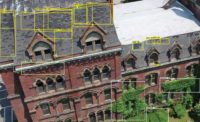Construction Tech
EarthCam Deploys Visual AI That Tracks Materials and Safety
EarthCam now sends materials delivery and installation data back to Procore, Autodesk platforms

EarthCam's Material Analysis feature uses visual AI to track materials on site, from deliveries to installation.
Image courtesy EarthCam
As recent advancements in artificial intelligence-based visual identification have progressed, construction jobsite monitoring provider EarthCam has been keen to bring these features to its wide network of cameras.
Now, as AI tech continues to make gains in sophistication, the company has gone beyond safety-related visual AI detection into active monitoring of materials deliveries and installations.
“The materials tracking [feature] has been in beta for a year; we just announced it at [Procore] Groundbreak,” explains Brian Cury, EarthCam CEO. The system has been trained up on EarthCam's own imagery from its countless jobsite cameras, and has integrations with Procore and Autodesk software for updating project progress based on schedule tasks based on EarthCam Material Analysis.
 Image courtesy EarthCam
Image courtesy EarthCam
“We like to say we’re not in the camera business, we’re in the software business,” says Cury. “We’re taking equipment and material deliveries to the jobsite, then sending that to Procore, putting it against the schedule with imagery,” he explains.
Alerts can be automatically generated when materials arrive on site, with a photo automatically appended. “So, say the HVAC ducts are delivered: Here’s a picture of the delivery. It’s these visual signal sources of truth that make the difference.”
 Image courtesy EarthCam
Image courtesy EarthCam
Cury sees the increased usage of visual detection AI as one key way to make up for deficiencies in the current state of construction scheduling.
“Schedules have been elongating since the pandemic, and the industry is trying to get it back in line,” he says. “But people aren’t communicating. The electrician shows up with his crew and the stud work is not up yet, so they may not show up for weeks once it is up. So we’ve moved toward alerts and color coding to help things along.”
The automatic color-coding of materials, as well as tracking installation progress, has been a requested feature according to Cury, citing many owners and developers who have turned to EarthCam and other camera systems to keep an eye on remote jobsites in recent years. But manually scrutinizing video footage to determine what work has been done is time-consuming and a natural fit for AI automation, he says.
Another unexpectedly popular feature has been using the visual AI to track how full trash containers are on jobsites, as it helps schedule the prompt removal of construction waste. “A full dumpster on the weekend is a fire hazard,” points out Cury, “so we know if its full or empty with AI.”
Improving Site Safety With AI
While materials and work tracking use cloud-based systems and focus on wider software integrations, EarthCam has also continued development on onboard camera AI processing for instantaneous safety alerts.
The company offers cameras with built-in AI analysis for tagging safety violations, including lack of PPE, fall risks or unsafe usage of equipment. In addition to noting common hazards such as spills or when someone is getting too close to an active piece of equipment, the visual AI can also tag workers working at height and evaluate if they are properly tied off.
 Image courtesy EarthCam
Image courtesy EarthCam
The edge detection for the working at height feature was a tricky bit of programming, says William Sharp, EarthCam vice president of product development. “We’ve gotten to where we can pick up [workers] on roofs, scaffold, lifts—the at-height verification works there as well.”
This was a challenge since these are static cameras positioned at odd angles, but EarthCam's visual processing has gotten to the point where the edge detection is fairly consistent regardless of the complex visual geometry, Sharp says. “I've been doing this for a long time. Every time we have a new challenge, we've been able to solve each one. As the challenges keep coming up. we'll keep solving them.”



